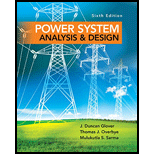
Power System Analysis and Design (MindTap Course List)
6th Edition
ISBN: 9781305632134
Author: J. Duncan Glover, Thomas Overbye, Mulukutla S. Sarma
Publisher: Cengage Learning
expand_more
expand_more
format_list_bulleted
Concept explainers
Question
Chapter 6, Problem 6.11MCQ
To determine
To fill: The appropriate word for the given blank spaces.
Expert Solution & Answer
Want to see the full answer?
Check out a sample textbook solution
Students have asked these similar questions
i need help with this question i tried by myself and so i am uploadding the question to be quided with step by step solution and please do not use chat gpt i am trying to learn thank you.
i need help with this question i tried by myself and so i am uploadding the question to be quided with step by step solution and please do not use chat gpt i am trying to learn thank you. i only need help with the second question please
i need help with this question i tried by myself and so i am uploadding the question to be quided with step by step solution and please do not use chat gpt i am trying to learn thank you. i only need help with the second question please
Chapter 6 Solutions
Power System Analysis and Design (MindTap Course List)
Ch. 6 - For a set of linear algebraic equations in matrix...Ch. 6 - For an NN square matrix A, in (N1) steps, the...Ch. 6 - Prob. 6.9MCQCh. 6 - Prob. 6.11MCQCh. 6 - Using Gauss elimination, solve the following...Ch. 6 - Prob. 6.9PCh. 6 - Determine the bus admittance matrix (Ybus) for the...Ch. 6 - Prob. 6.34PCh. 6 - Prob. 6.37PCh. 6 - Prob. 6.38P
Knowledge Booster
Learn more about
Need a deep-dive on the concept behind this application? Look no further. Learn more about this topic, electrical-engineering and related others by exploring similar questions and additional content below.Similar questions
- 3) Find the valve of V using the Thevenin Equivalent Circuit and then determine if the 8 ohm resistor allows maximum power transfer. If not, then what value should the 8 ohm resist or be changed to for maximum power transfer? ZA 360 Am 6t + 22V V 3402 22 62 Mw marrow_forwardFind the valve of the voltage Vx using the THEVENIN 2) equivalent circuit and redo the problem with the NORTON equivalent circuit. Show both the flavinen and Norton Circuits DAY ww 1 23 www + 4444 5 63arrow_forwardFigure shows the block diagram of a feedback control system with a disturbance signal N(s). Obtain the output Y(s) due to both R(s) and N(s).arrow_forward
arrow_back_ios
SEE MORE QUESTIONS
arrow_forward_ios
Recommended textbooks for you
 Power System Analysis and Design (MindTap Course ...Electrical EngineeringISBN:9781305632134Author:J. Duncan Glover, Thomas Overbye, Mulukutla S. SarmaPublisher:Cengage Learning
Power System Analysis and Design (MindTap Course ...Electrical EngineeringISBN:9781305632134Author:J. Duncan Glover, Thomas Overbye, Mulukutla S. SarmaPublisher:Cengage Learning

Power System Analysis and Design (MindTap Course ...
Electrical Engineering
ISBN:9781305632134
Author:J. Duncan Glover, Thomas Overbye, Mulukutla S. Sarma
Publisher:Cengage Learning